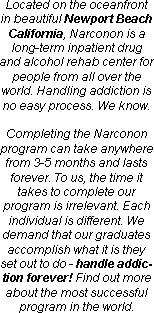
|
Navigate |
| Home |
| Kirstie Alley |
| Our 30th Anniversary |
| Never Turning Back |
| Narconon Endorsements |
| |
|
|
| |
|
|
| |
|
Facts About Drugs |
| FAQ About Ambien |
| FAQ About Ativan |
| FAQ About Cocaine |
| FAQ About Codeine |
| FAQ About Crack |
| FAQ About Darvocet |
| FAQ About Dexedrine |
| FAQ About Demerol |
| FAQ About Dilaudid |
| FAQ About Ecstasy |
| FAQ About GHB |
| FAQ About Heroin |
| FAQ About Hydrocodone |
| FAQ About Ketamine |
| FAQ About Lortab |
| FAQ About LSD |
| FAQ About Marijuana |
| FAQ About Morphine |
| FAQ About Meth |
| FAQ About Methadone |
| FAQ About Opiates |
| FAQ About Opium |
| FAQ About Oxycontin |
| FAQ About Percocet |
| FAQ About Percodan |
| FAQ About Ritalin |
| FAQ About Rohypnol |
| FAQ About Ultram |
| FAQ About Valium |
| FAQ About Vicodin |
| FAQ About Xanax |
  |
|
Resources |

|


 Print this article |  Send this article to a friend |  Add to Favorites |
FAQ
About Ketamine
Q) What is Ketamine?
A) Ketamine is a short-acting "dissociative" anesthetic due to its ability to separate perception from sensation. It also has hallucinogenic and painkilling qualities that seem to affect people in very different ways. . Ketamine is chemically related to PCP ('Angel Dust'). Ketamine is occasionally administered to people but, more commonly, is used by vets for pet surgery. Generally street K is most often diverted in liquid form from vets' offices or medical suppliers.
Q) How is Ketamine used?
A) Special K is prepared by evaporating the liquid from the legitimate pharmaceutical injectable product and grinding the residue into a powder. Drying of the liquid has been reported to be accomplished by placing the liquid on warming trays, pancake griddles, or cast-iron skillets placed on low heat. More recent reports describe the use of microwaves to achieve a fast boiling-off of the liquid to dry crystals. There has been no reported clandestine manufacture of ketamine (which would be a difficult process). All of the ketamine encountered by law enforcement to date has been diverted from licit sources, burglaries of veterinary clinics being the most frequently reported source.
Special-K is usually snorted or swallowed as a powder or injected as a liquid intramuscularly. Sometimes, it is put on tobacco or marijuana and smoked. It is distributed as powder in small "personal use" cocaine-like bottles, ziplock bags, capsules, or paper, glassine or aluminum 'folds', or as a liquid in small vials or bottles. Specialized "puff pumpers", small bottles with a small inhaler screw-on top designed to deliver approx. 40 mg of ketamine crystals, have been sold in "Rave" clubs. A 10 ml vial of veterinary product containing one gram of ketamine sells, on average, for $100 on the street. A typical street package of powder (100 - 200 mg) sells for about $20. In the past, other drugs were not usually mixed with ketamine, now however, MDMA, amphetamine, methamphetamine, cocaine, carisoprodol, and flunitrazepam have been encountered.
Ketamine
as "Special K" or "K" has become a staple at 'rave' parties.
It produces a dose-related progression of effects from a state of dreamy intoxication
to delirium accompanied by the inability to move, feel pain or remember what has
occurred while under the drug's influence.
Q) What are the effects of Ketamine?
A) I.M. (intra-muscular injection) Ketamine generally takes 1-5 minutes to take effect. Snorted ketamine takes a little longer at 5-15 minutes. Depending on how much and how recently one has eaten, oral ketamine can take between 5 and 30 minutes to take effect. The primary effects of ketamine last approximately an 30-45 minutes if injected, 45-60 minutes when snorted, and 1-2 hours if used orally. The Drug Enforcement Administration reports that the drug can still affect the body for up to 24 hours.
- Hallucinations- it blocks chemical messengers in the brain that carry sensory input; the brain fills the resulting void with visions, dreams, memories, whatever
- Visual distortions
- Lost sense of time, senses, and identity
- Euphoria
- Confusion
- Smells and tastes seem muted
- Visual perception and sense of touch are amplified
- May feel floaty- slightly or far away from your body
- Numbness in your extremities
- K
Hole- comparatively similar to a near death experience, with the sensation of
rising above one's body, inner peace, and radiant light.
Q) What are the side effects of Ketamine?
A)
The use of Ketamine can result in profound physical and mental problems including
delirium, amnesia, impaired motor function and potentially fatal respiratory problems.
Panic, rage and paranoia may also occur. Some people feel paralyzed by the drug,
unable to speak without slurring, while others either feel sick or actually throw
up. While using Ketamine one is less likely to feel pain and in turn could end
up inflicting injury or harm to themselves without even knowing it. In addition,
one can be submerged in their hallucinations without realizing that they are hallucinating.
Eating or drinking before taking the drug can cause vomiting.
Information
regarding the long-term effects of Ketamine is mainly anecdotal. Flashbacks of
experiences and hallucinations while under the influence of the drug have been
reported. There have also been suggestions that long-term use of Ketamine can
damage the memory and eyesight of the user, as well as reducing attention span.
Frequent use can cause disruptions in consciousness and lead to neuroses or other
mental disorders.
A
BBC report in May 2000 claimed that medical research had shown that controlled
tests on Ketamine users had revealed impaired memory and mild schizophrenia several
days after taking the drug.
Two
psychological difficulties which seem to come up for those who use Ketamine regularly
are paranoia and egocentrism. There are many reports of regular users starting
to see patterns and coincidences (synchronicities) in the world around them which
seem to indicate that they are somehow more important or integral to the world
than others. This same sense of the world focusing on the user can also feed into
a sense of paranoia.
A main characteristic of Ketamine is a stupor similar
to extreme drunkenness. This is commonly known as "being in the K-hole."
- increase heart rate
- slurred speech
- paralyzed feeling
- nausea
- unable to move
- hallucination
- numbness
- impaired attention, memory and learning ability
- delirium,
amnesia, impaired motor function, high blood pressure, depression and potentially
fatal respiratory problems at higher doses
Q) Can you overdose on Ketamine?
A) Yes, an overdose of Ketamine will knock you out as if in an operating room. If repeatedly taken in large doses, Ketamine can induce unconsciousness and failure of the cardiovascular system, leading to death. There are at least seven Ketamine related deaths known nationally.
Q) Is Ketamine addictive?
A) Yes, Ketamine can cause a tremendous psychological dependence and may be physically addicting as well. The dissociation from one's consciousness experienced with Special K (the entrance to "K-Land") can be highly seductive, and there are many cases of Ketamine addiction. If used regularly, users of Special K can quickly build a tolerance to the drugs effects. Special K is illegal and possession can result in long prison terms.
Q) What are the slang terms used for Ketamine?
A) Special K, Ketalar, Ketaject, Ketaset, Super-K, "K", Ket Kat, Cat Valium, Vitamin K
Q) What is the history behind Ketamine?
A)
Abuse of Ketamine (pronounced Kee-ta-meen) goes hand in hand with gamma hydroxy
butyrate (GHB) and MDMA (Ecstasy). Where you find one, you will likely find the
others. All three are very popular with the RAVE party crowd. Ketamine hcl, a
cat tranquilizer and the most commonly used anesthetic in the Vietnam War. It
was popular in the 70's. Ketamine is a psychedelic anesthetic classified medically
as a dissociative anesthetic, discovered by Dr. Cal Stevens of Wayne State University
in 1961. Heavily used on the battlefields of Vietnam, it is used today for short-term
surgical procedures in both animals and humans. It is sold only to hospitals and
physicians. Since it does not depress critical body vitals, it is often used in
procedures with burn victims for example.
Special K has exploded in the past few months onto the suburban drug scene. In February, the U.S. Drug Enforcement Administration warned that use is increasing at teen "rave" parties, the marathon dances that have spawned a new youth subculture. Anti-drug czar Barry McCaffrey's office added K to its list of "emerging drugs" in 1995; the office's latest "pulse check" of the nation found K "all over." St. Louis, Mo., Tampa, Fla., and suburban New Jersey have seen a rash of animal-hospital break-ins by thieves hunting for Ketamine.
If
you have a problem with ketamine addiction call Narconon Southern California drug
rehab center, we can help 1800 US NO DRUGS

comment corner
 |
| drug rehabilitation saving taxpayers |
California taxpayers are saving more money than expected due to ... |
 |
| Study: Marijuana Causes Lung Damage |
New research finds that smoking three or four marijuana cigarettes ... |
 |
| Thanks to Online Pharmacies, Addiction Can Be Just a Click Away |
WASHINGTON -- Kelly Knable, a 34-year-old mother of three from ... |
 |
| Balancing pain and drug addiction |
Over the past two decades, two conflicting medical ideas have ... |
 |
| Clean break |
... |
 |
| State officials create prescription drug abuse task force |
TALLAHASSEE, Fla. -- State officials on Friday announced the creation ... |
 |
| Florida system often fails to catch Medicaid abuse at source |
FORT LAUDERDALE, Fla. - (KRT) - The victim's skin was ... |
 |
| Marijuana's rising threat: For more kids, use turns into addiction |
John Brown experimented with marijuana at age 10, and it ... |
 |
| Student gets state prison term for selling marijuana |
EASTON -- David Messina had his whole life ahead of ... |
 |
| Man charged in cocaine case forfeits $585,000 |
An Iowa truck driver arrested by Kentucky Vehicle Enforcement officers ... |
 |
| Cocaine Curtails Body's Ability to Cool Off |
In addition to triggering life-threatening cardiovascular episodes, cocaine can be ... |
 |
| Science for Cops |
I admit it: I'm a Law & Order fan. ... |
 |
| New Gene Therapy Could Help Quell Alcoholic Cravings |
One prevailing view of addiction holds that alcohol and other ... |
 |
| One Dose of Cocaine Primes the Brain for Addiction |
It isn't a myth: one dose of cocaine is all ... |
 |
| Marijuana Firmly Linked to Infertility |
Scientists from the University of Buffalo have smoked out what ... |
 |
| Moderate Alcohol Consumption Clouds Brain's Ability to Detect Mistakes |
It's common knowledge that a brain on booze doesn't function ... |
|
Narconon Pictures |
|
   |
|